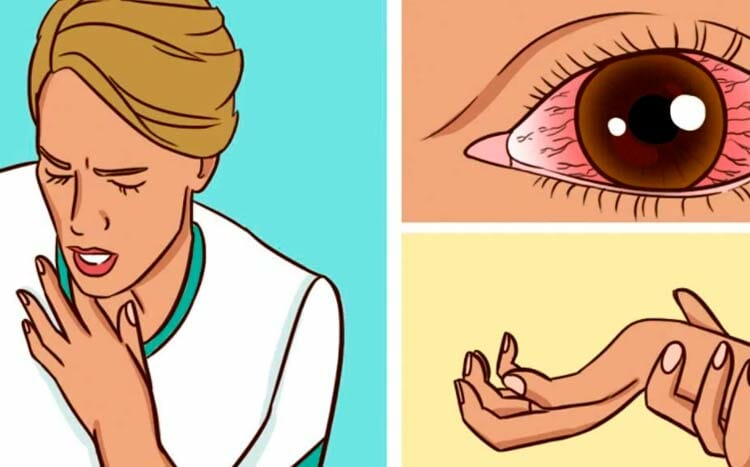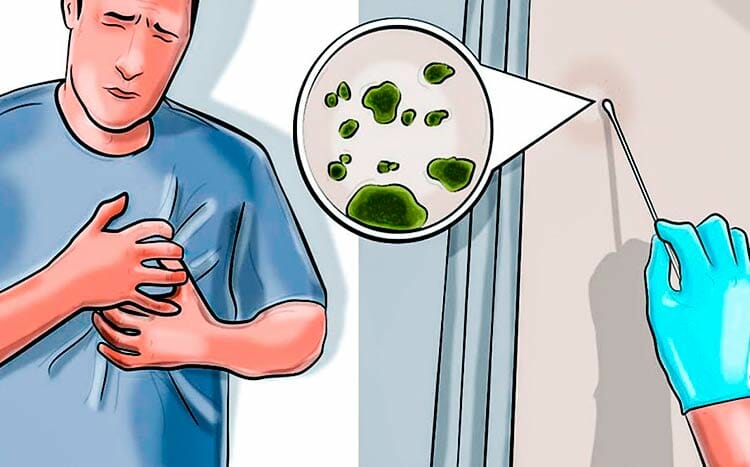Areas that are damp and not properly ventilated are commonly recognized as ideal conditions for the growth of mold. However, a combination of different factors must be present before a person begins to exhibit symptoms related to exposure to mold.
Mold normally grows in such places within 24 to 48 hours after exposure. Mold exposure can immediately affect persons with underlying health conditions such as allergies and asthma. It may however take longer to affect those without such health conditions.
Other factors which include the amount of mold present in an environment also influence the duration it takes for one to start developing the symptoms that line up with such exposure. This is usually based on one’s degree of mold sensitivity.
Minimal exposure is known to result in either mild or no symptoms at all after long time periods. Exposure to a great deal of mold can however result in health symptoms and complications within a relatively short period of time.
Those suffering from underlying respiratory conditions and allergies are therefore advised to wear masks so as to avoid inhaling large amounts of mold which may lead to health complications.
How do you know if mold is making you sick?
One of the most accurate ways of finding out if mold is making you sick is trace the source of your symptoms. If your symptoms only appear in a specific environment, then there is a high likelihood that the said place is mold-infested.
In such cases, people are advised to check for the presence of any form of decaying matter and moist surface that is likely to be the main source of such an infestation. Visible mold growth is also a great indicator that mold exposure may be affecting your health.
The following are the major symptoms that are known to manifest as a result of exposure to mold:

Allergic Reactions
These are especially common among those allergic to any kind of mold exposure. For such people, these reactions may even occur under environments with a normal concentration of mold.
Although the symptoms vary from person to person the most common ones include nasal blockage, dry coughs, sore and itchy throats, red and watery eyes and skin irritations.
Serious symptoms such as wheezing, shortness of breath and chest congestion can however occur in cases involving people with severe allergies. Pre-existing respiratory health conditions like asthma may also be worsened in environments with a large amount of mold.
Fungal Infections
Mold is generally known to cause fungal infections among people whose immune system has been weakened. Chemotherapy and organ patients are usually at the top of the list as far as weakened immune systems are concerned.
Such infections may also occur among young infants who may even stand a risk of developing respiratory and skin illnesses as result of the said mold exposure.
Food Poisoning
Mold can at times begin to grow in food which may have overstayed its freshness. Eating such food may result in a condition of inner poisoning otherwise known as Mycotoxicosis. It is usually advisable to seek professional medical assistance in such scenarios.
How much mold exposure is harmful?
Even though moisture quantities vary from atmosphere to atmosphere, mold is generally known to be present in all places. This therefore means that all people are usually exposed to mold albeit in normal quantities.
Mold normally begins to get harmful when it starts to excessively multiply in indoor environments. In such cases, it usually begins to facilitate the rotting of indoor organic substances such as food and wood.
Human health conditions which include allergies and respiratory illnesses are also likely to develop in these kinds of environments.
It is however important to note that mold in itself is not usually dangerous. It is generally its toxins and spores as opposed to the mold itself that actually makes us sick.
How does mold affect you and other people?
Mold can affect different people at different times and in different ways depending on the conditions in which they are living. In terms of health, it is known to trigger a wide range of symptoms which are relatively mild for healthy people.
These symptoms may be a little more serious for people with weakened immune systems. Mold can however not directly cause chronic respiratory illnesses such as lung cancer and the like.
Mold is also known to cause excessive damage of indoor organic materials especially in cases where its growth is left unchecked. Wooden furnishings and fittings may therefore be left extremely damaged in such cases.
Organic food substances may also be destroyed as a result of mold exposure.
How dangerous is mold to health?
Exposure to mold is generally not known to cause any severe chronic respiratory illnesses. It can however result in a wide range of symptoms and eventually lead to the exasperation of conditions such as asthma if not controlled.
Mild exposure which normally occurs when relatively healthy people are exposed to little quantities of mold is generally harmless. Light symptoms such as coughing and nasal irritation can however occur once the amount of mold increases.
Severe exposure which usually takes place when a sensitive person is exposed to large quantities of mold for long periods of time has the potential to be deadly.
This is because it can be able to cause underlying health conditions and allergies to worsen thus leading to more serious health complications.

How long does it take for black mold to affect you?
Black mold is a type of mold whose spores are dormant as a result of unfavourable growing conditions. These spores are known to put a stop to active growth until they can encounter favourable growing conditions. It is this dormant state that usually makes the mold turn black hence its name.
More often than not, black mold can only affect you when it is able to encounter favourable conditions such as moist and stuffy atmospheres. It can take between 24 to 48 hours to grow and release harmful poisonous substances otherwise known as Mycotoxins.
If such growth is not curtailed black mold can affect different people at different times depending on their sensitivity to mold, the strength of their immune system and the amount of mold they have been exposed to.
Who is at the most risk of health problems associated with mold?
The people at most risk of health problems associated with mold are generally those whose immune system has either been weakened or is not strong enough due to underdevelopment.
Older adults as well as chronically ill patients are normally part of the former. Those who are part of the latter include infants and toddlers. People suffering from allergies as well as other underlying respiratory health conditions such as asthma are also considered a risk group.
It is however also important to point out that mold exposure can be detrimental to anyone’s health especially when it is in large amounts for long periods of time.
FAQ's
How do you know if you have a mold problem?
Mold problems are generally identified by a wide range of signs which include:
Musty smell
A musty smell is a great indicator of the presence of mold especially since it normally occurs under the same damp conditions that mold grows in.
Discoloration
This is one of the more visual signs of mold infestation. Most mold infested surfaces usually have tiny clusters of black spots. Others may appear as green and white thread-like deposits.
Water Leakage Indicators
These typically include peeling paint and water stains on the walls and ceiling. They can seldom be noticed at first which means that one may be dealing with a serious mold problem by the time they become conspicuous.
Previous Water Damage
Previous water damage may also result in mold infestation especially if it was not thoroughly dealt with from the root.
How can I test myself for mold exposure?
Mold exposure can be tested by professional medics through blood and skin prick tests. Blood tests usually look for any antibodies which may indicate sensitivity to a variety of mold forms.
Skin prick tests on the other hand normally test whether one is allergic to mold or not by exposing their skin to a given mold species.
How long does it take to detox from mold exposure?
It generally takes between 1 to 2 days to completely detox oneself from mold exposure. This also includes removing the source of the mold as well as properly cleaning and ventilating the area that was mold infested. It is advisable to hire mold remediation specialists for such an exercise.
https://homegardenguides.com/mold/ is a great tool that quickly matches you with the best mold testing and remediation specialists in your locality. You can get three estimates from local mold testing and remediation professionals in a matter of two minutes. Kindly follow the steps below to enjoy this great service:
- Scroll to the top of the page and enter your zip code
- Answer questions about your drywall job
- Your mold testing and remediation details are forwarded to three local experts who will send you a price estimate for your job with some friendly advice.
Is it safe to sleep in a room with mold?
It is generally not considered safe to sleep in a room that is heavily infested with mold. This is because it can be able to cause certain health risks which include allergic reactions. It is however important to note that






